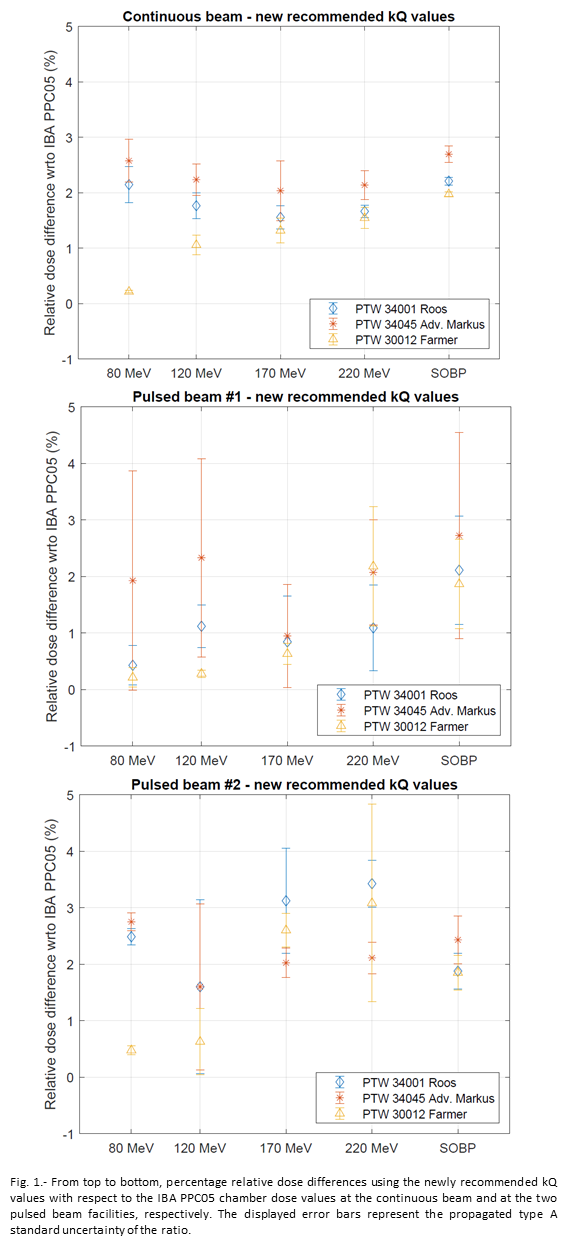Comparison of cylindrical and plane-parallel ionization chambers in continuous and pulsed proton PBS
Gloria Vilches-Freixas,
The Netherlands
OC-0928
Abstract
Comparison of cylindrical and plane-parallel ionization chambers in continuous and pulsed proton PBS
Authors: Gloria Vilches-Freixas1, Ana Lourenço2,3, Alex Douralis2, Jonathan Martens1, Arturs Meijers4,5, Hugo Palmans2,6, Ilaria Rinaldi1, Koen Salvo7, Russell Thomas2,3, Geert Bosmans1
1Department of Radiation Oncology (MAASTRO), GROW School for Oncology, Maastricht University Medical Centre+, Maastricht, The Netherlands; 2National Physical Laboratory, (NPL), Teddington, United Kingdom; 3University College London, (UCL), London, United Kingdom; 4Department of Radiation Oncology, University Medical Center Groningen, University of Groningen, Groningen, The Netherlands; 5Center for Proton Therapy, Paul Scherrer Institute, Villigen, Switzerland; 6MedAustron Ion Therapy Center, Medical Physics Group, Wiener Neustadt, Austria; 7Department of Radiotherapy, AZ Sint-Maarten, Mechelen, Belgium
Show Affiliations
Hide Affiliations
Purpose or Objective
In this experimental work we compared dose measurements using four ionization chambers (ICs), i.e., three plane parallel (PP) chambers and one Farmer-type chamber, irradiated under the same conditions in one continuous cyclotron-accelerated proton beam (IBA Proteus PLUS) and in two pulsed-scanned synchrocyclotron-accelerated proton beams (IBA Proteus ONE and MEVION Hyperscan 250i).
Material and Methods
Measurements were performed using a PTW-34045 Advanced Markus, PTW-34001 Roos, IBA-PPC05 and PTW-30012 Farmer. The chambers were positioned at 2 cm depth in a water phantom in four square-field single-energy scanned proton beams with nominal energies between 80 and 220 MeV and in the middle of a 10x10x10 cm3 dose cube centered at 10 cm depth in water. To reduce uncertainties due to traceability, all chambers were calibrated at the same primary standard laboratory. IC readings were corrected for ambient conditions, polarity, and ion recombination. We used the beam quality (kQ) correction factors for the chambers under investigation from IAEA TRS-398, newly calculated Monte Carlo (MC) values and IAEA TRS-398 updated recommendations (Palmans et al. 2022). For the Farmer-type chamber placed at 2cm depth of single-energy beams we used an empirical model to account for the displacement correction factor. For the PP chambers the water-equivalent thickness (WET) of the entrance window was accounted for in positioning the inner surface of the window at the measurement depth.
Results
The polarity correction factor was found to be unity for all chambers and beam qualities, within experimental uncertainties. Ion recombination factors increased with beam energy with values up to 0.7%, 3.5%, and 7.6% for the PTW Farmer 30012 (operated at 400V) and up to 0.2%, 2%, and 3.7% for the PTW Roos 34001 (operated at 300V) in the continuous, and in the two pulsed beams, respectively. Dose differences among the four chambers ranged between 0.8% and 3.0% using the TRS-398 kQ values and increased to between 1% and 3.4% with the newly recommended kQ values. The largest differences were observed between the IBA PPC05 and the rest of the chambers, which agreed within one standard deviation, as shown in Figure 1.

Conclusion
The observed dose differences between the chambers appear to be related to inconsistencies in the determination of the kQ values. For PP ICs, MC studies account for the physical thickness of the entrance window rather than the water equivalent thickness. The additional energy loss that the wall material invokes is not negligible for the IBA PPC05 and might partially explain the low kQ values determined for this chamber and, hence, the lower dose values measured in all facilities for this chamber. Furthermore, the new kQ recommended values increase the observed dose differences between chambers. To resolve these inconsistencies and to benchmark the MC calculated values, kQ measured values by calorimetry are needed.